This post may contain affiliate links. Please see our disclosure policy.
Canning cajun red beans and sausage is a delicious way to put up a flavorful meal in a jar right on your pantry shelf. Also known as Louisiana Red Beans, these seasoned beans are usually served with rice, which cooks quickly, and is easy to prepare at mealtime.
The beans are the hard part, and take much longer to cook…but if you can them ahead of time, it makes for a quick last-minute meal.
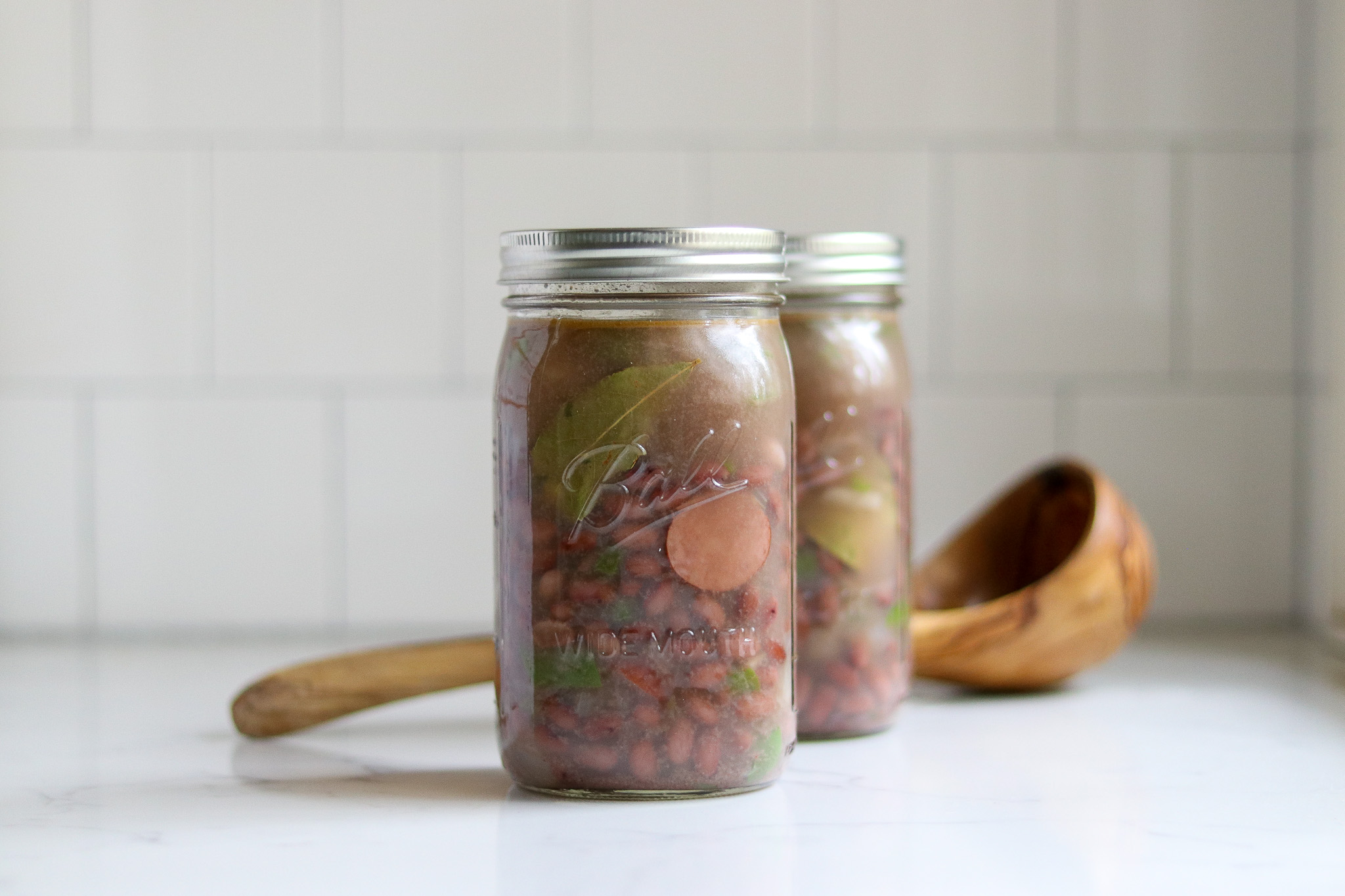
Cajun red beans and rice is a classic dish with many rich flavors and spices.
Not only does this traditional dish have a delicious flavor, but it’s perfectly safe for canning provided that you make the rice separately as serving. The beans are the hard part, and rice cook quickly on the stove. That means it’s not only also an easy meal to can and keep stored for months, it’s also easy to serve too.
The process of canning Cajun Red Beans involves soaking the beans overnight in water, cooking them in a combination of flavorful ingredients such as onions, garlic, bay leaves, and Cajun seasoning, and then sealing them into jars with boiling liquid.
The result is a delicious Southern-style meal that can be heated up quickly any day of the week. Once canned, these red beans make a fantastic addition to rice, gumbo, or any other favorite dish!
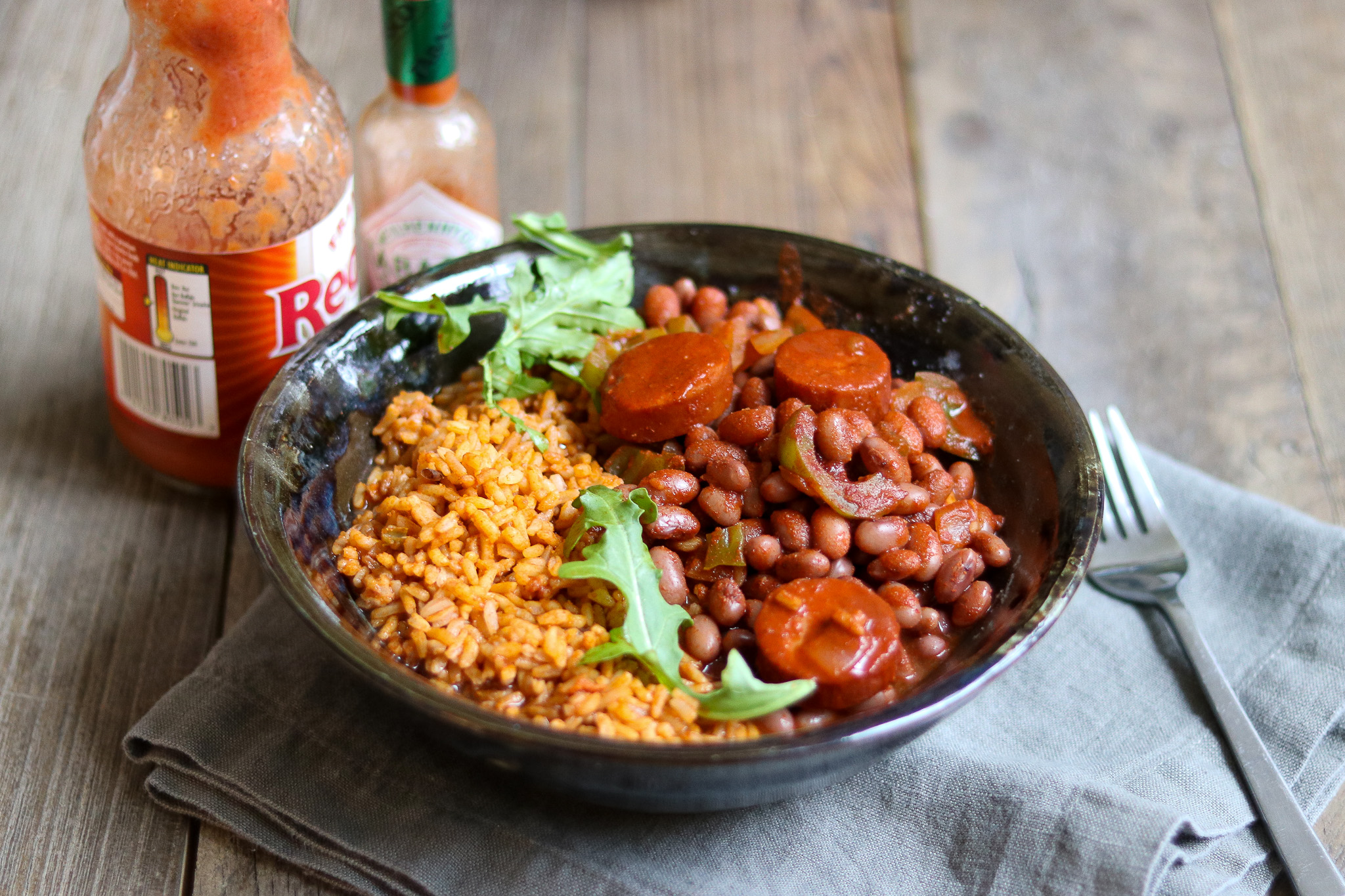
This recipe for canning Cajun red beans is a safe, tested canning recipe that’s adapted using safe canning guidelines. Ball Canning has a recipe for canning Louisiana Red Beans, as does Bernardin.
My particular variation combines Ball’s recipe with the recipe in Angi Schneider’s Pressure Canning for Beginners and Beyond, and I’ve made it a bit easier to source the ingredients by using common pantry staples.
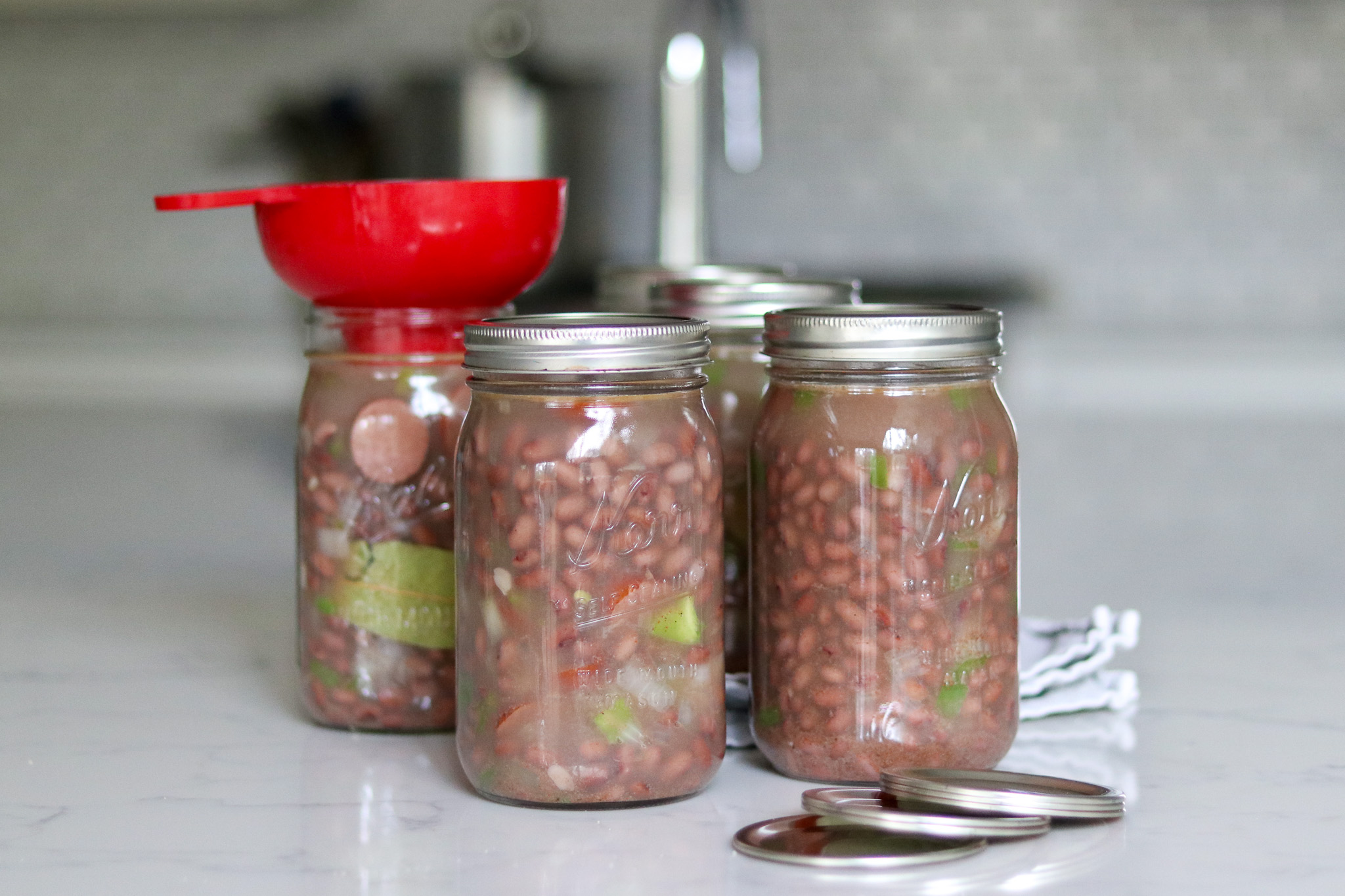
Ingredients for Canning Cajun Red Beans
The ingredients for canning cajun red beans are quite simple. To make a canner batch of 14 pints (or 7 quarts) of cajun red beans, you’ll need the following:
- 2 lbs dried red beans, pre-soaked
- 6 cups (1.4 L) water
- 6 cups (1.4 L) chicken broth
- 4 cups (650 g) onions, finely chopped
- 2 cups (225 g) bell peppers, chopped
- 2 tbsp (35 g) canning salt
- 3 tbsp (36 g) Cajun seasoning (see notes)
- 2 tbsp (15 g) garlic powder
- 7 bay leaves (one per quart jar)
- 2 lbs cased sausage, smoked or cooked, sliced, such as Andouille sausage (optional)
- 1 lb bacon, thick cut (optional)
There are a few adjustments you can make to this recipe to suit your tastes, and I’ll take you through those one by one. All of these variations follow the guidelines for safe canning put out through the National Center for Home Food Preservation.
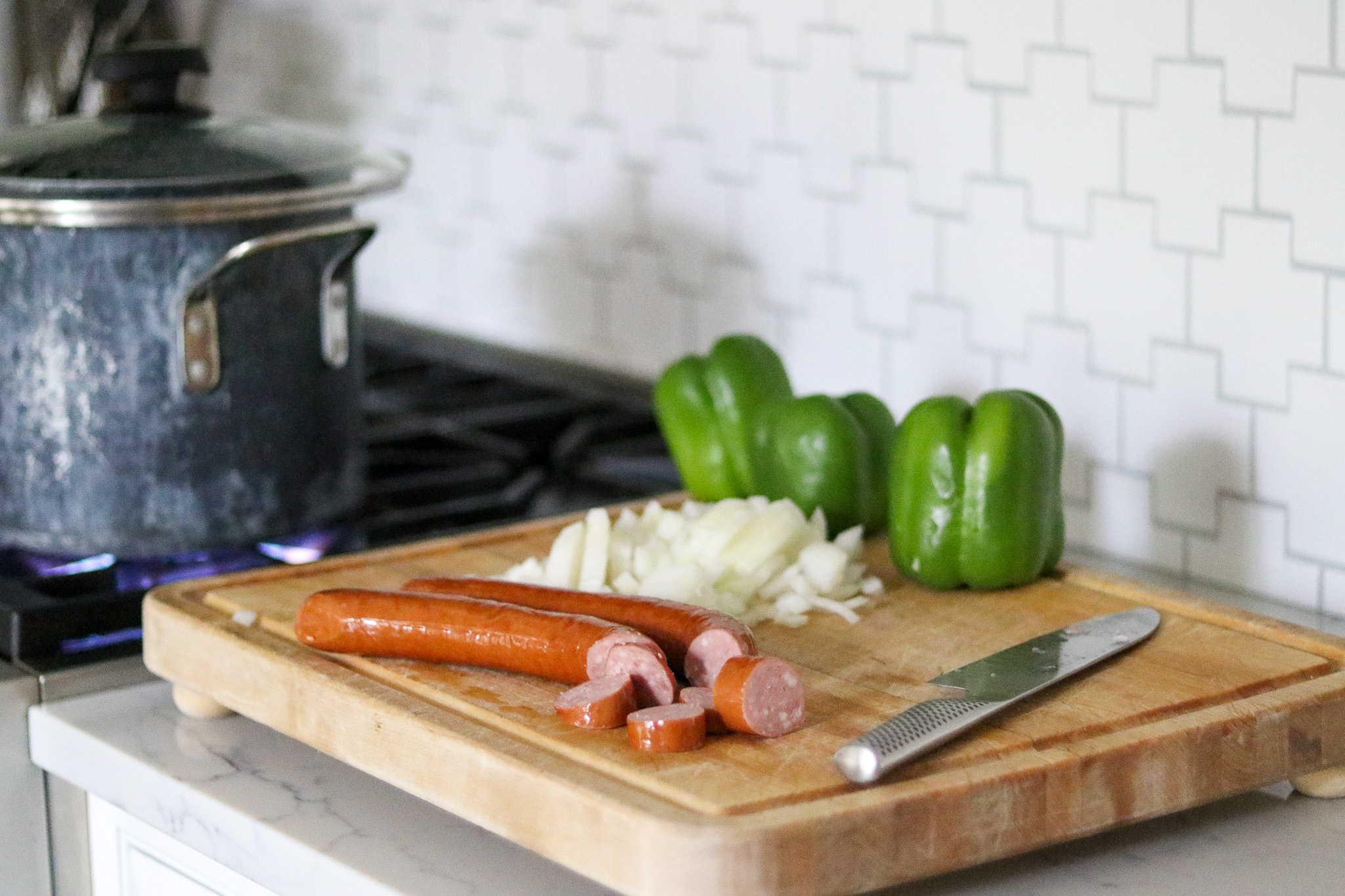
The beans in this recipe are weighed or measured, and then pre-soaked overnight. This allows the beans to fully re-hydrate, which is essential for canning. If not soaked, the beans will re-hydrate using the liquid in the jars, which will leave the jars too dry for canning.
You can also use the “quick soak” method instead of overnight soaking.
To do that, place the beans in plenty of water and bring them to a boil in a pot on the stove. Boil 1 minute, then turn off the heat and leave them standing in the hot water for an hour.
Drain, and proceed with the recipe using the drained “quick soaked” beans in place of overnight beans.
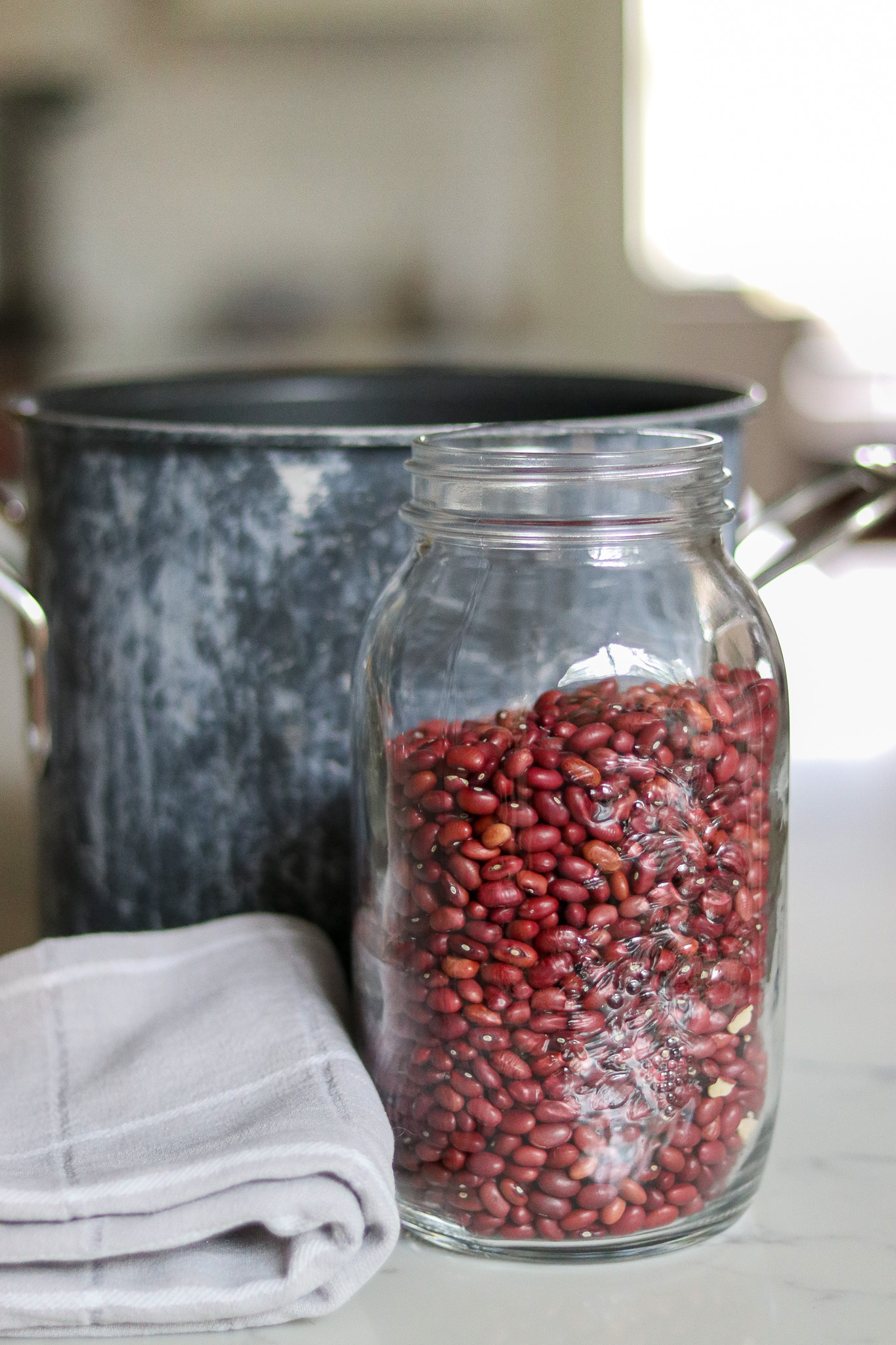
The veggies in this recipe are onions and peppers. Both are optional, and you don’t have to add them. You will need a bit more liquid to fully fill the jars, but just add boiling water.
If you do choose to add them, don’t use more than the recipe specifies.
For onions, the recipe calls for 4 cups chopped, which is about 1 1/2 pounds onions as purchased.
For peppers, you may use any type of pepper, hot or sweet. You can also substitute canned peppers in place of fresh. If using bell peppers, you’ll need about 2 to 3 medium bell peppers to make 2 cups chopped.
You may use a few cloves of minced garlic in this recipe in place of the garlic powder.
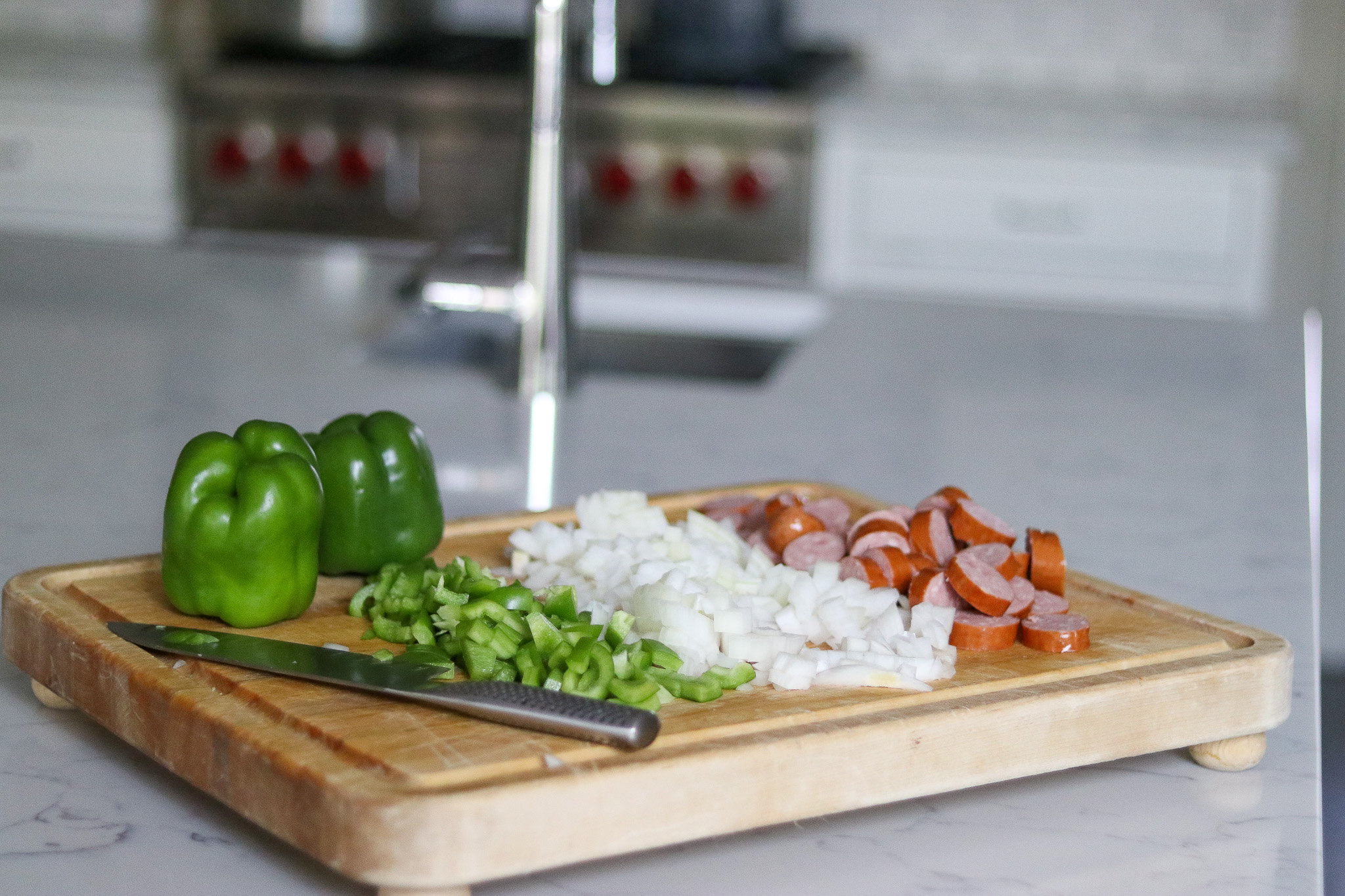
The spices in this recipe are flexible, as they are in any pressure canning recipe.
You’re always allowed to change the quantities and proportions of dry spices in canning recipes, provided you use reasonable amounts.
When they say “reasonable amounts” they mean don’t turn the whole thing into a spice paste by using 3 cups of onion powder, but normal seasoning amounts are fine.
Ball’s recipe for Louisiana Red Beans just uses dried thyme and bay leaves, nothing else. I think that’s not going to give you the best result, or at least not a particularly “Cajun” red bean recipe.
Most traditional red bean recipes have a lot more flavor than that!
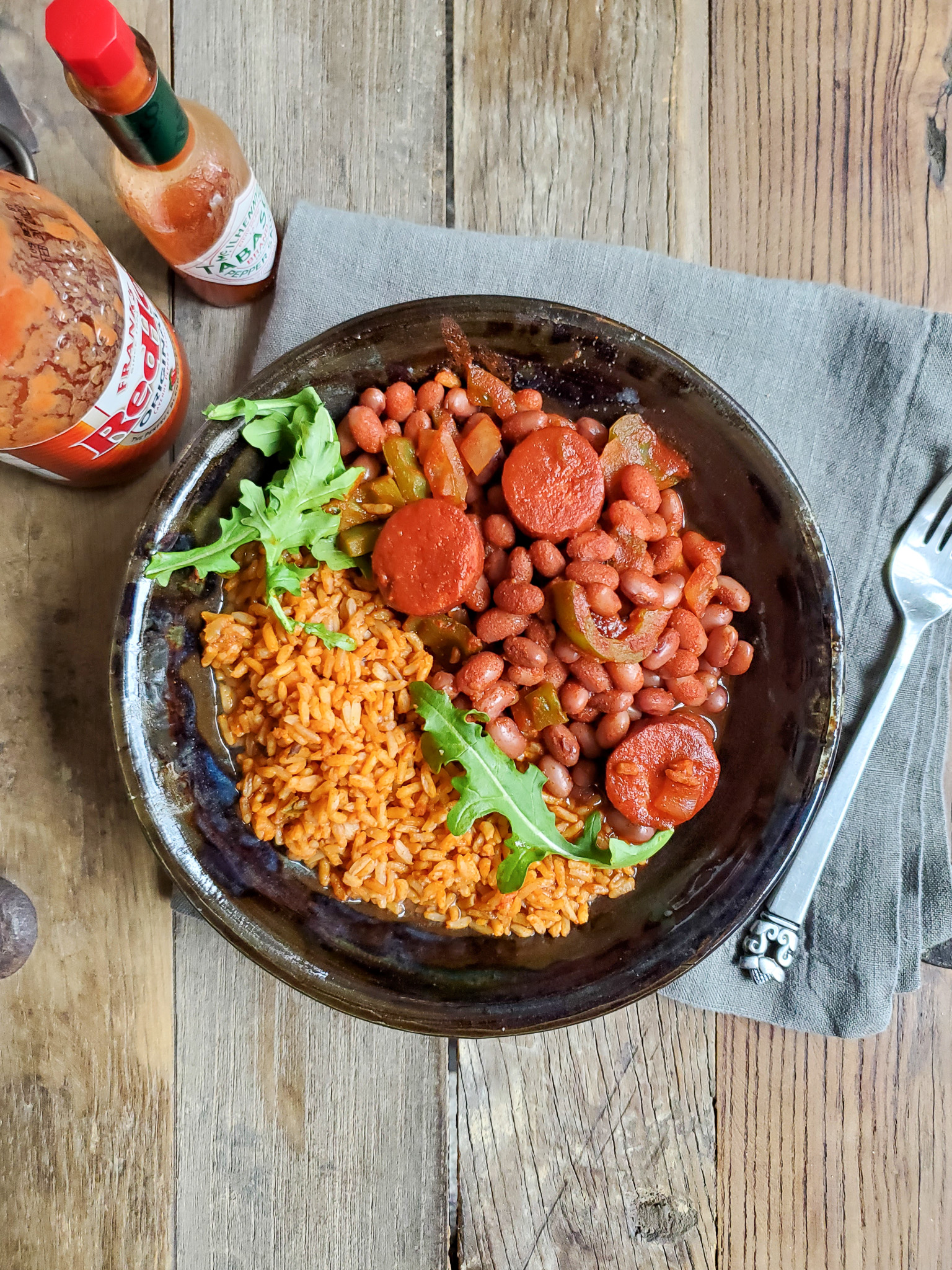
Angi Schneider’s recipe uses 2 Tablespoons of “Cajun Seasoning” but that’s not easy to source outside of the south. Generally, Cajun seasoning includes:
- Paprika (sweet or smoked)
- Garlic Powder
- Onion Powder
- White Pepper
- Black Pepper
- Oregano
- Thyme
- Cayenne
I’ve increase the spicing a bit to 3 Tbsp Cajun seasoning or creole seasoning, which can be made with the following ingredients:
- 2 tsp Oregano, dried
- 2 tsp Thyme, dried
- 2 tsp White Pepper, ground
- 1 tsp Black Pepper
- 1 tsp Garlic powder
- 1 to 3 tsp Cayenne (optional, adjust to you heat level)
All theses spices are optional, and you can adjust to your tastes.

For the Andouille sausage, Angi’s recipe makes it clear that it can be any sausage, provided it’s uncured. Uncured means it doesn’t contain nitrites or nitrates.
Generally, “cured” meats aren’t used in canning recipes because they’re a bit denser than regular meats and heat doesn’t penetrate as well. There are a number of exceptions, however, and home canned baked beans is one of them. Ham and bean soup is another.
If you’re using a tested recipe that includes a cured meat, then it’s fine to use.
Ball Canning’s recipe uses regular smoked Andouille, and does not specify that you need nitrite free. It also includes regular bacon, which definitely contains nitrites, but they’ve tested this recipe using both of those. Lastly, the ball canning recipe also has you make your own ham stock using a ham bone, and then picking off and adding the remaining cured ham to the recipe.
I’d go with your own comfort level here, and choose whichever you feel comfortable using in this recipe, either cured or uncured.
Either way, don’t increase the total amount, and be sure it’s sliced (not in whole chunks).

Canning Cajun Red Beans
When you’re ready to start canning, prepare your pressure canner according to the manufacturer’s instructions. This usually means adding 2-3 inches of water into the bottom and bringing it up to a gentle simmer (180 F) for hot pack.
Also prepare jars, lids, and rings. This recipe makes 7 quarts or 14 pints, so plan accordingly. (Your jars will be a bit short, as you should only be filling the jars about 3/4 full with solids and then topping with broth or boiling water.)
Drain your soaked beans and then add them to a stock pot with 6 cups water and 6 cups stock (or use all broth/stock). Bring the mixture to a hard boil, and then reduce the heat and allow the mixture to boil gently for 30 minutes.
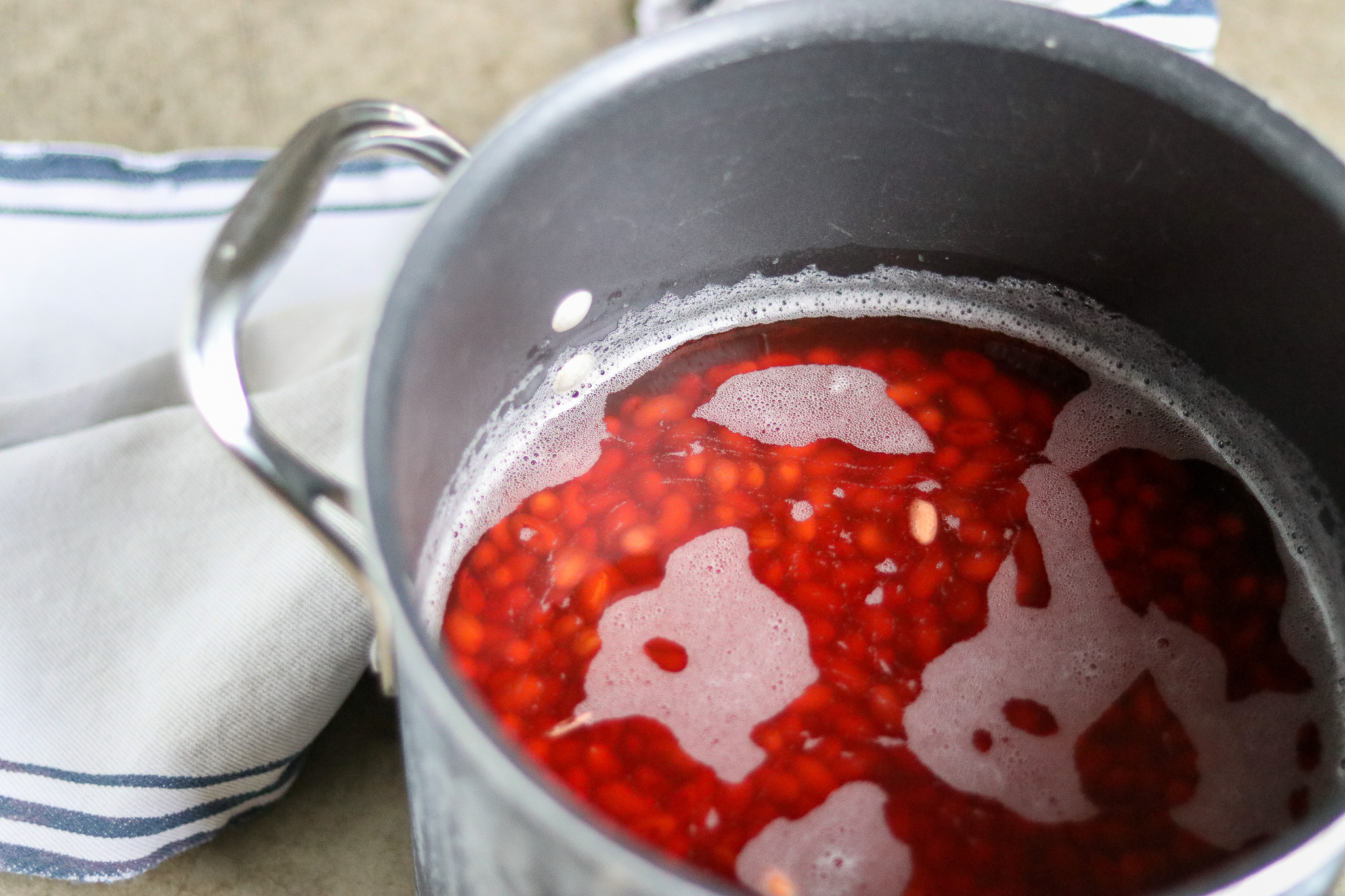
While you are preparing the beans, chop the onions and bell peppers. Add the peppers, onions, and all spices (with the exception of the bay leaves) to the pot.
Slice the sausage, and chop the bacon into small pieces. Brown both on the stove and add them to the pot.
At this point, everything should be in the pot except for the bay leaves.
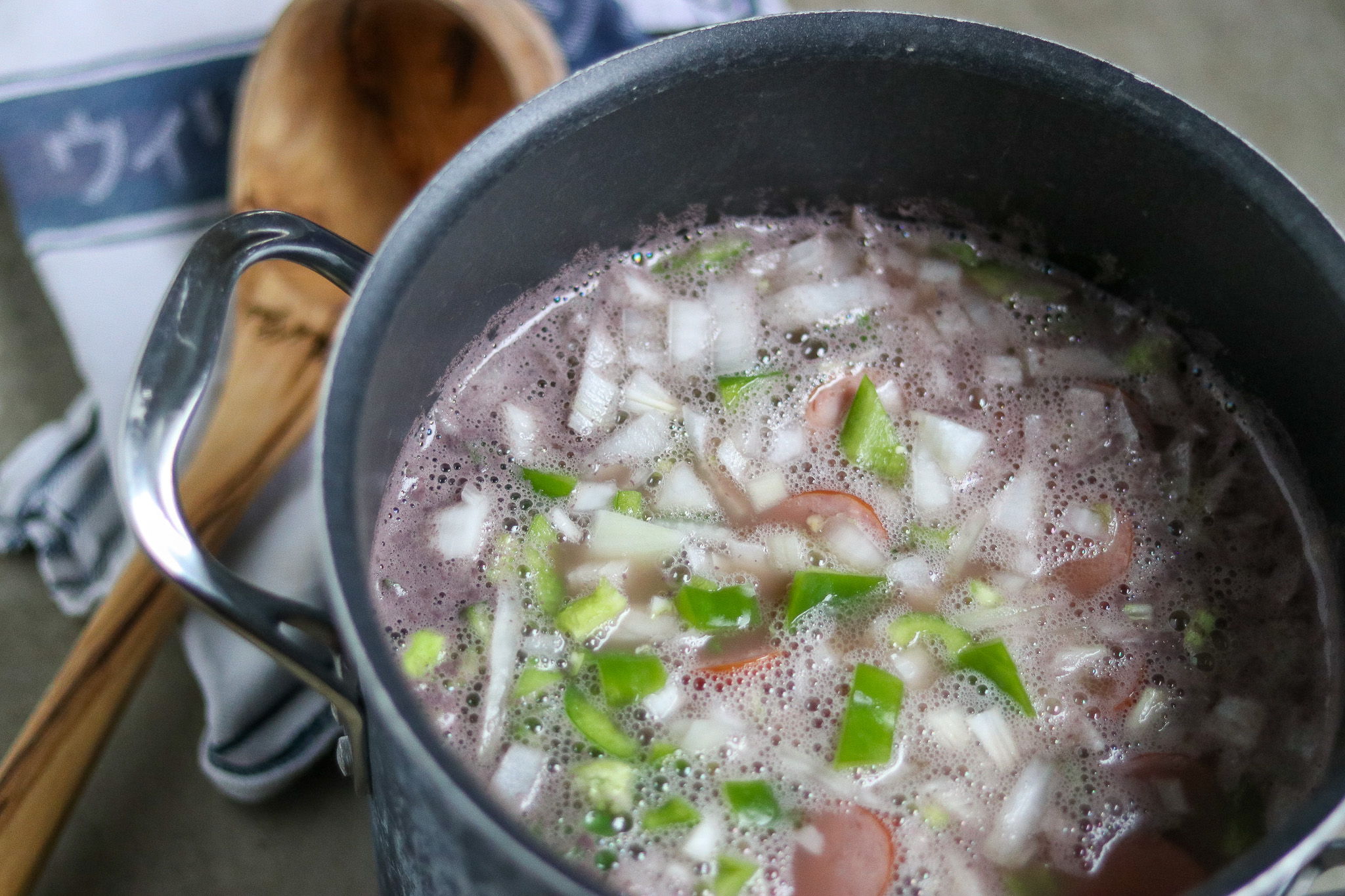
After 30 minutes, take the pot of beans, meat and vegetables off the heat and ladle them into the hot jars.
(Note: The only thing that really needs this 30 minute cook is the beans. Everything else needs a minimum of 5 minutes at a simmer to come up to temperature. If you add all the veggies/meat at the end, be sure to simmer it 5 more minutes before putting everything into jars.)
Be sure to evenly distribute everything across all 7 quarts (or 14 pints). The jars should only be about 3/4 full of solids, and you’ll be topping them off with the cooking liquid to reach 1” headspace.
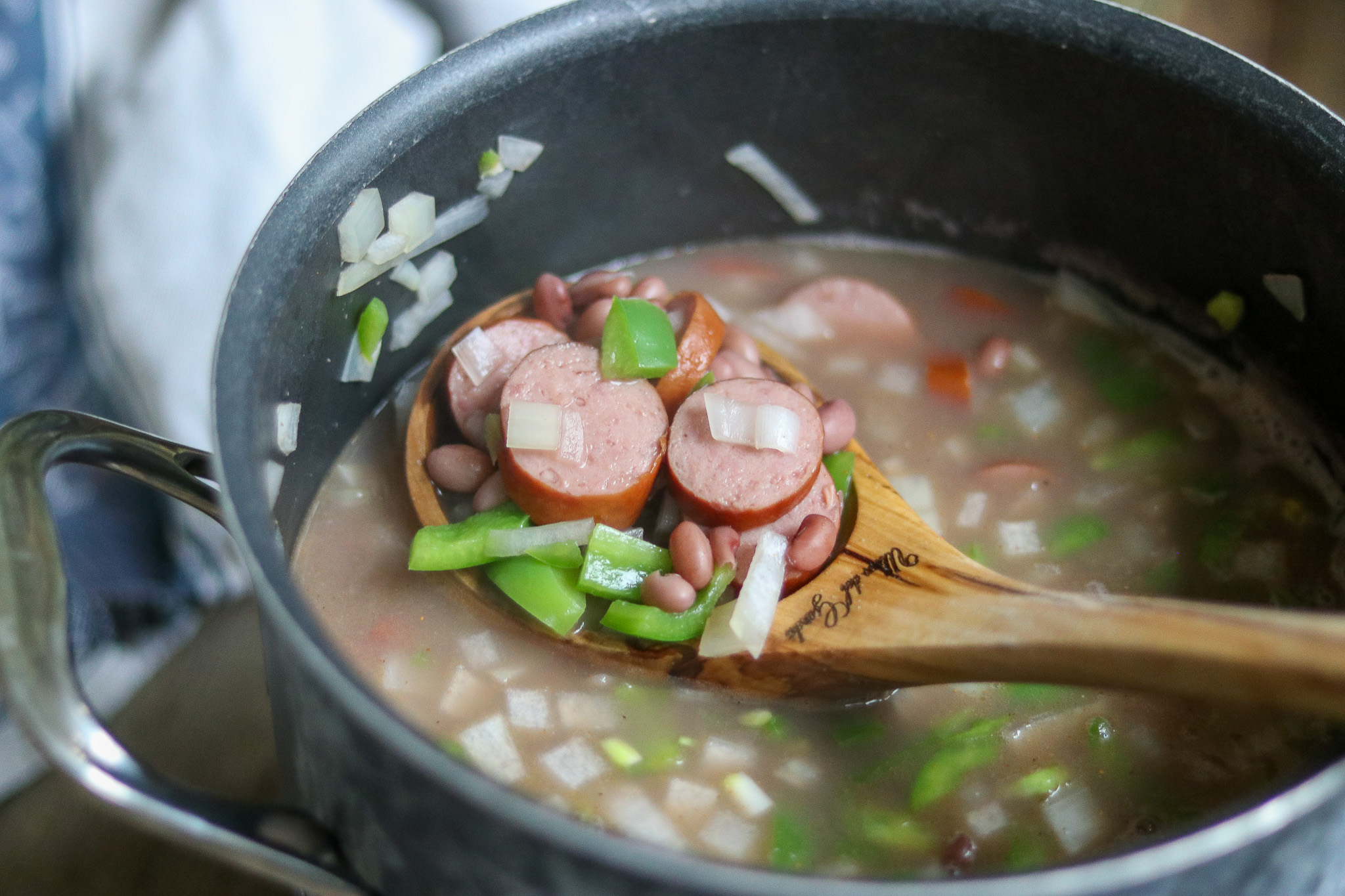
Once everything’s evenly distributed across all the jars, it’s time to add the broth from the cooking pot.
Fill the jars with the remaining cooking broth, leaving 1” headspace. If you’re short on liquid, add boiling water to fill to within 1” of the top of the jar.
Add a single bay leaf to each quart jar, or a half leaf to each pint jar.
(The solids may float, that’s fine. Just add them first so you can make sure they’re evenly distributed before you fill with liquid.)

Use a bubble removal tool to remove any bubbles, then double-check that you still have 1 inch of headspace.
If the jars aren’t completely filled, you can add boiling water to top them off (again, remembering to maintain that 1 inch headspace).
If your stove runs a bit hotter, you may have lost more liquid during the cook time for the beans. Be ready with a kettle of boiling water on the side so you can fill the jars if needed.
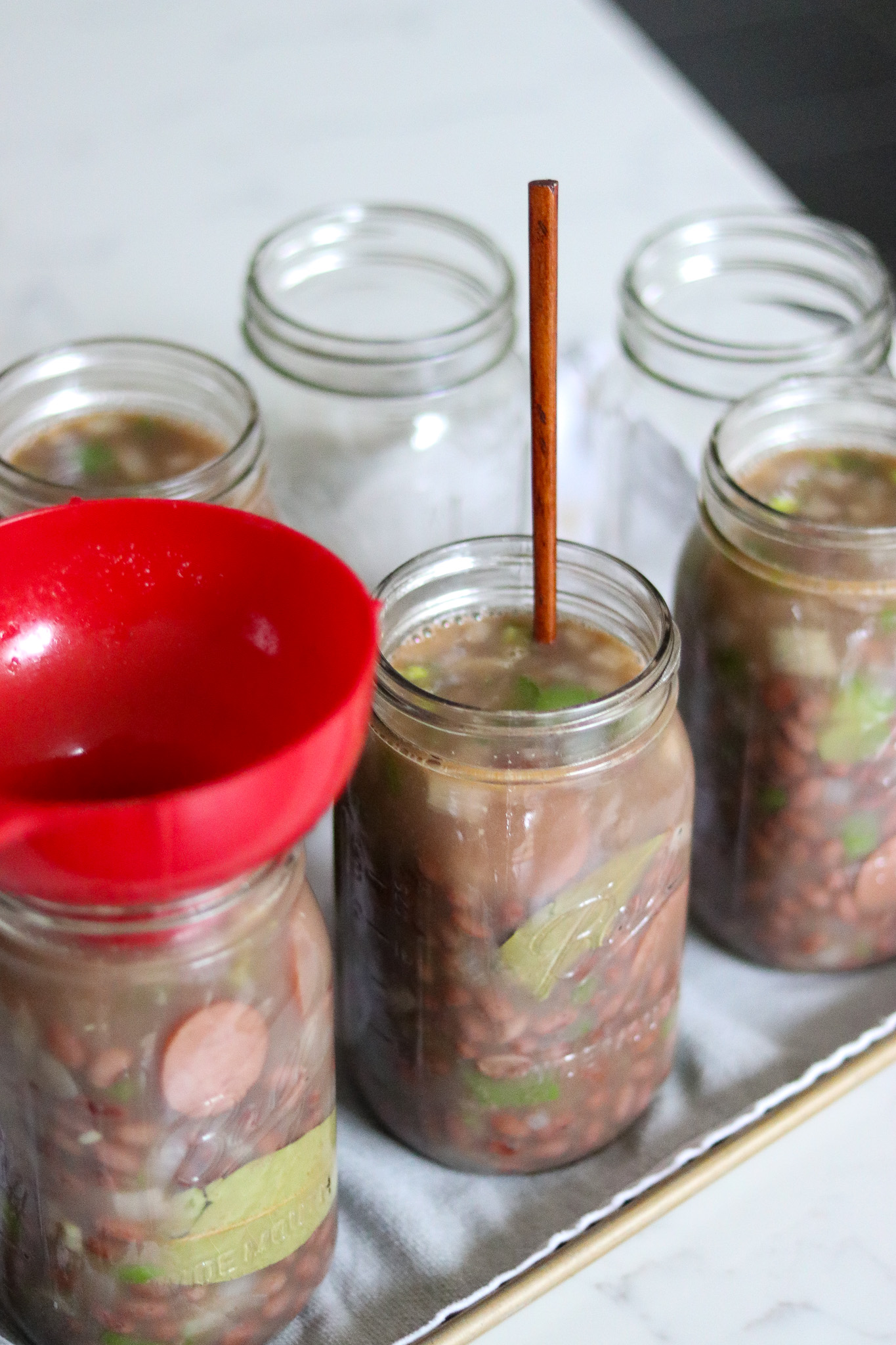
Wipe the jar rims with a clean cloth and place the lids and rings on the jars, screwing them on until they are fingertip tight, then load them into the pressure canner.
Process the jars at 10 lbs of pressure for 75 minutes for pint jars and 90 minutes for quart jars (also 10 lbs pressure). If you’re over 1,000 feet in elevation, adjust the pressure to your altitude (see below).

Altitude Adjustments
Canning time remains the same regardless of altitude, however, the processing pressure increases as altitude increase.
Use the following table to determine the correct processing pressure if you’re above 1,000 feet in elevation.
For dial gauge pressure canners:
- 0 to 2,000 feet in elevation – 11 lbs pressure
- 2,001 to 4,000 feet in elevation – 12 lbs pressure
- 4,001 to 6,000 feet in elevation – 13 lbs pressure
- 6,001 to 8,000 feet in elevation – 14 lbs pressure
For weighted gauge pressure canners:
- 0 to 1,000 feet in elevation – 10 lbs pressure
- Above 1,000 feet – 15 lbs pressure
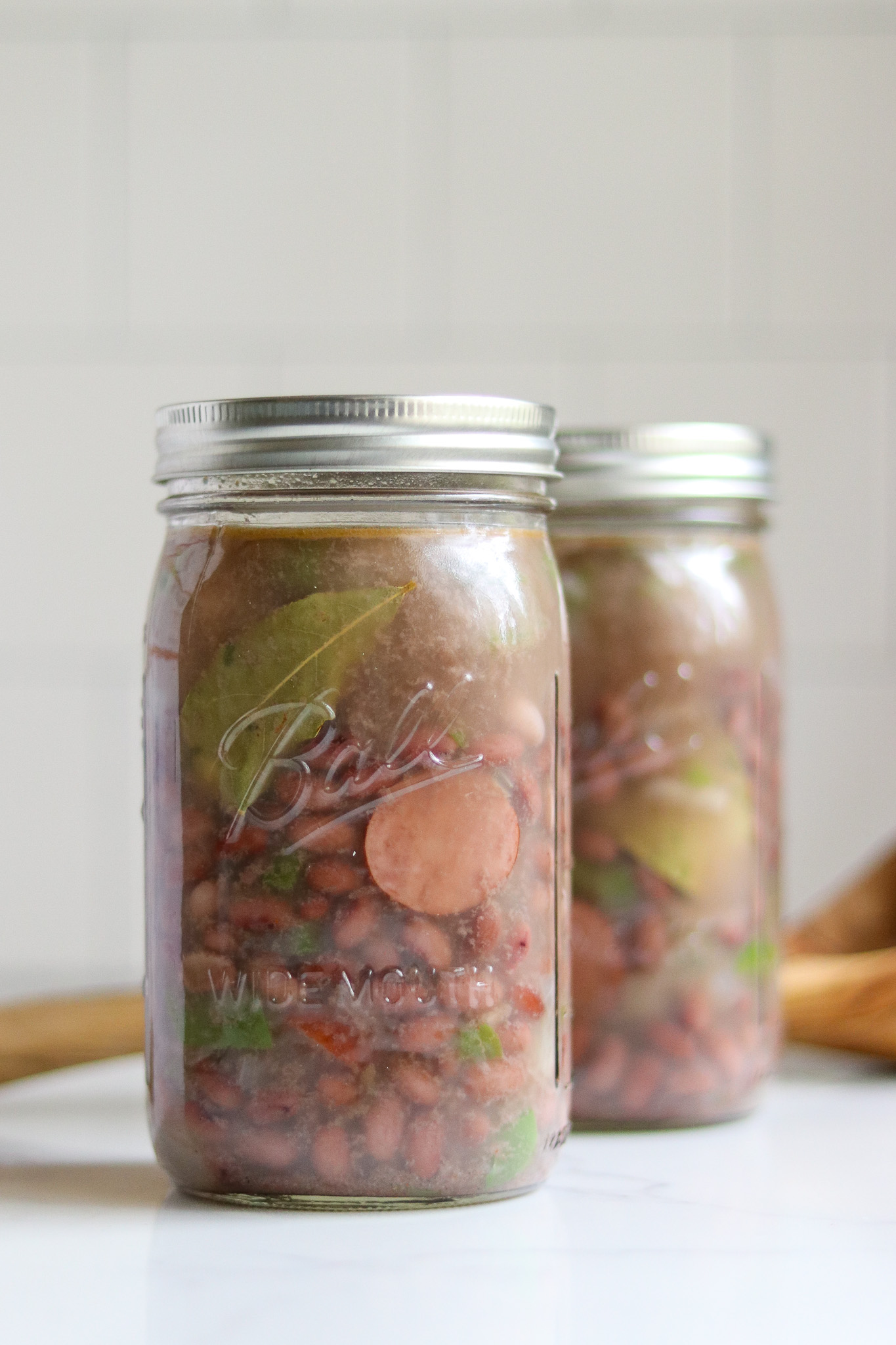
Serving Cajun Red Beans
To serve your home canned Cajun red beans on their own, pour a jar into a medium stockpot and heat for 10 minutes, or until the liquid is bubbling and the beans are cooked through. Remove the bay leaf and serve.
Cajun red beans are a hearty and flavorful dish that pairs perfectly with a variety of main entrees. The dish can be served over cooked white rice or alongside hot French bread for a complete Cajun feast. You can also add a dollop of sour cream or a sprinkling of cheese on top.
No matter what you choose, you’re sure to love the results – and you probably won’t have any leftovers to worry about!

Meal in a Jar Canning Recipes
I have dozens of meal-in-a-jar canning recipes to keep your pantry full!
- Canning Beef Stew
- Canning Boston Baked Beans
- Canning Split Pea Soup
- Canning Sausage, Potato and Kale Soup
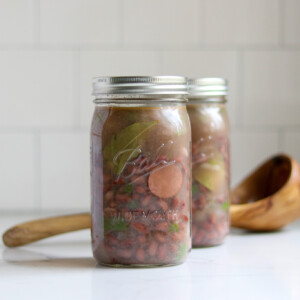
Canning Cajun Red Beans & Sausage
Equipment
Ingredients
- 2 lbs dried red beans, pre-soaked
- 6 cups water
- 6 cups chicken broth
- 4 cups onions, finely chopped
- 2 cups bell peppers, chopped
- 2 tbsp canning salt
- 3 tbsp Cajun seasoning, see notes
- 2 tbsp garlic powder
- 7 medium bay leaves, one per quart jar
- 2 lbs cased sausage, smoked or cooked, sliced, such as Andouille sausage (optional)
- 1 lb bacon, thick cut (optional)
Instructions
- Prepare the pressure canner according to the manufacturers instructions. Also prepare jars, lids and rings.
- Drain the water from your soaked beans, then place them in a stockpot with 6 cups water and 6 cups chicken broth. Bring to a steady boil over high heat, then reduce the heat and simmer for 30 minutes. (Start another kettle of water simmering right before you begin ladling everything into jars, as sometimes you need more boiling water to top off the jars.)
- While the beans are cooking, chop the onions and peppers. Add all the chopped vegetables to the pot, along with the seasonings (all but the bay leaves).
- Slice the sausage, and chop the bacon into small pieces. Brown both on the stove over medium heat, and then add them to the cooking bean pot.
- After 30 minutes total cook time, remove the beans from the heat and ladle into hot jars. (The beans and veggies should cook for a minimum of 5 minutes.) Be sure to divide all the solids evenly between the jars. They'll only be about 3/4 full.
- Add 1 bay leaf to each quart jar, and 1/2 leaf to each pint.
- Top off each jar with the liquid you used to boil the beans, adding more boiling water if necessary. Leave 1" of headspace.
- De-bubble jars and re-adjust headspace if necessary.
- Wipe the rims of the jars with a damp cloth to clean. Put the lids and rings on the jar, tightening them until they are fingertip-tight.
- Load the jars into the pressure canner and process at 10 lbs pressure for 75 minutes for pints, 90 minutes for quarts.
- After the time has elapsed, allow the canner to depressurize naturally. Remove the jars and allow them to cool for 12 hours. Store in a cool, dark place for up to one year.
Notes
Ingredients Notes
Generally, canning recipes should be followed exactly to ensure safe processing. However, there are some small changes you can make to a recipe that still follow the guidelines from the National Center for Food Preservation.Broth/Water
You can use all broth or all water in this recipe, or a combination of the two. A simple chicken broth works well, but a ham hock broth or pork broth works even better. Vegetable stock will help make this a vegetarian recipe, provided you omit the added meats as well.Beans
The beans need to soak overnight in plenty of water before you begin cooking this recipe. If you forget to soak the beans, you can use the quick soak method. To do that, place the beans in plenty of water and bring them to a boil in a pot on the stove. Boil 1 minute, then turn off the heat and leave them standing in the hot water for an hour.Drain, and proceed with the recipe using the drained "quick soaked" beans in place of overnight beans.
Vegetables
The veggies in this recipe are onions and peppers. Both are optional, and you don't have to add them. You will need a bit more liquid to fully fill the jars, but just add boiling water. If you do choose to add them, don't use more than the recipe specifies.For onions, the recipe calls for 4 cups chopped, which is about 1 1/2 pounds onions as purchased. For peppers, you may use any type of pepper, hot or sweet. You can also substitute canned peppers in place of fresh. If using bell peppers, you'll need about 2 to 3 medium bell peppers to make 2 cups chopped.
Spices
You're allowed to change the amount, type and quantites of dry spices in canning recipes without affecting canning safety. Use whatever spices you choose, provided they're dry spices. This recipe calls for "Cajun Seasoning" or "Creole Seasoning" which may be hard to find. To make 3 Tablespoons of Cajun Seasoning, use the following:- 2 tsp Oregano, dried
- 2 tsp Thyme, dried
- 2 tsp White Pepper, ground
- 1 tsp Black Pepper
- 1 tsp Garlic powder
- 1 to 3 tsp Cayenne (optional, adjust to you heat level)
Andouille Sausage
Generally, you're not allowed to use cured meats (ham, bacon, etc) in canning recipes, except where they'd been specifically tested. The cured andouille sausage and cured bacon in this recipe were tested by ball canning. They're optional, and you can make this as a vegetarian canning recipe. If you do choose to use the meats, do not increase the quantities, and be sure to slice them as directed (rather than putting in large chunks).Altitude Adjustments
Canning time remains the same regardless of altitude, however, the processing pressure increases as altitude increase. Use the following table to determine the correct processing pressure if you’re above 1,000 feet in elevation. For dial gauge pressure canners:- 0 to 2,000 feet in elevation – 11 lbs pressure
- 2,001 to 4,000 feet in elevation – 12 lbs pressure
- 4,001 to 6,000 feet in elevation – 13 lbs pressure
- 6,001 to 8,000 feet in elevation – 14 lbs pressure
- 0 to 1,000 feet in elevation – 10 lbs pressure
- Above 1,000 feet – 15 lbs pressure
Nutrition
Nutrition information is automatically calculated, so should only be used as an approximation.
Pressure Canning Recipes
Fill those pantry shelves with these pressure-canning recipes!
Bean Canning Recipes
Looking for more ways to put up beans in a jar?
- Cuban Black Bean Soup
- Chipotle Black Bean Soup
- Canning Boston Baked Beans
- Canning White Bean and Greens Soup
- Butternut Squash and White Bean Soup
- Cajun Red Beans and Sausage
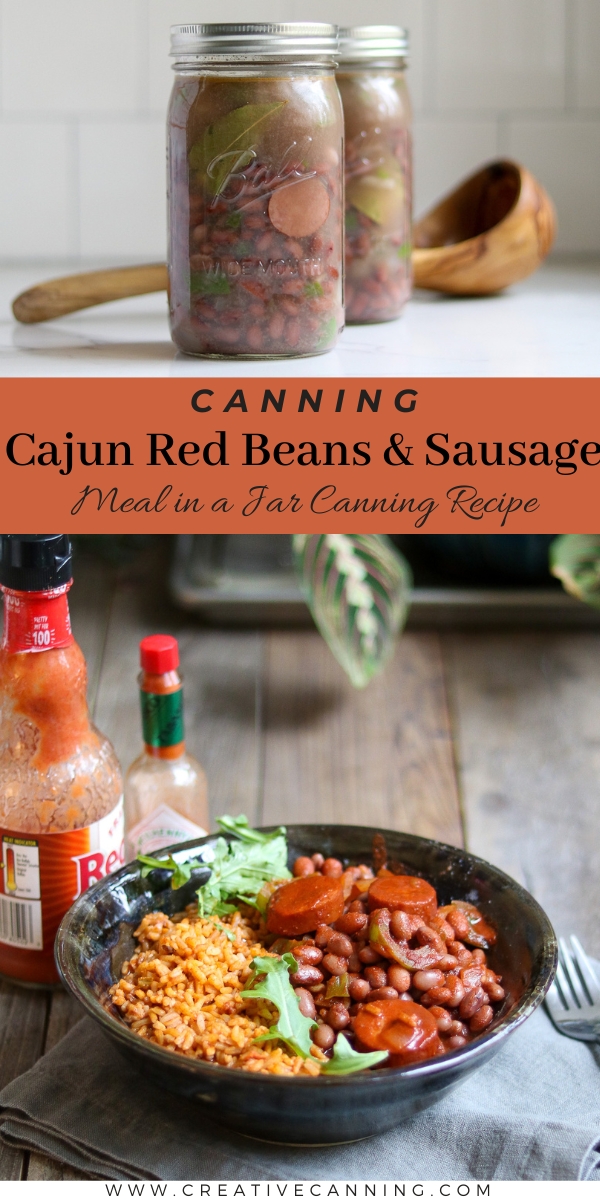
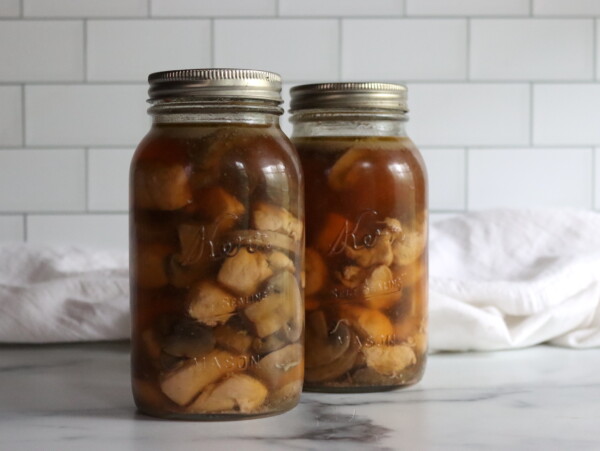
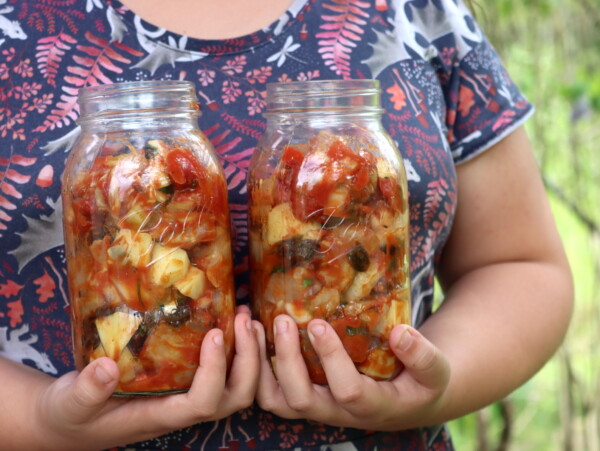
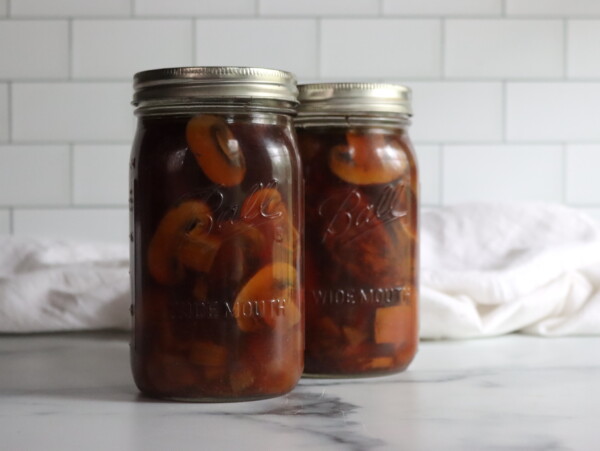
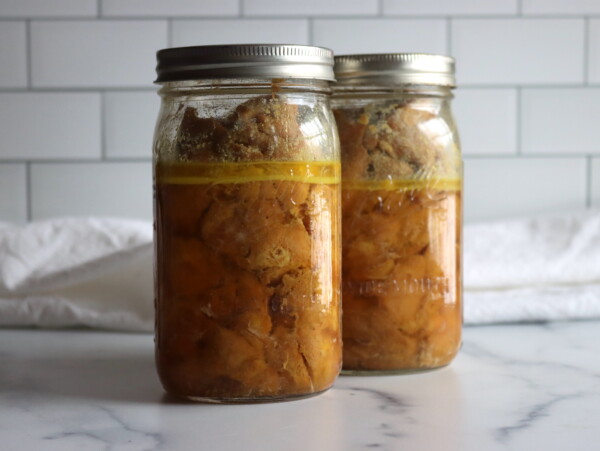
My kids LOVED this!
Lovely!
With a few tweaks, I think this could easily and safely become Brazilian black beans!!
This looks amazing, thank you for sharing!!
Oh for sure! I’ve had cuban black beans, but had to look up Brazilian Black Beans. It looks like they’re pretty similar, and there’s even a tested canning recipe for Cuban Black Beans (and it’s amazing): https://creativecanning.com/canning-cuban-black-bean-soup/
Im making the ball recipe today, and have a hard time making anything Cajun without the “holy trinity” of onion, bell peppers, and celery! I think ill decrease the onion and bell peppers slightly and squeeze in some celery. Your version, with the cajun spices, sounds much more flavorful than the original!
Hi 🙋♀️
Thanks for sharing all of your great recipes.
Would it be ok to saute the vegetables before adding to the beans?
Yup, that’s perfectly fine. Enjoy!
I would love to try canning this recipe. Do the beans continue to soak up the liquid after the jars have been processed?
The beans do soak up more liquid in the canning process, so you do need to leave quite a bit of liquid in the jar and not pack it too tightly. Once they come out of the canner though, they’re done plumping, and whatever liquid is in there is going to stay.